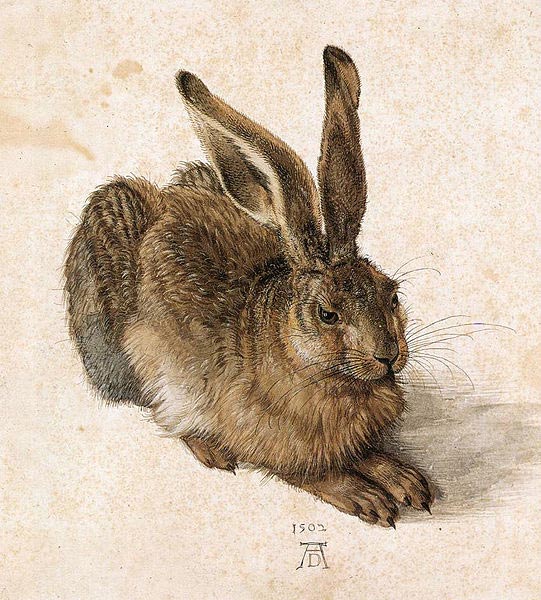| Young Hare | |
|---|---|
 |
|
| Artist | Albrecht Dürer |
| Year | 1502 |
| Medium | Watercolour and bodycolour on a cream wash |
| Location | Albertina, Vienna |
| Dimensions | 9.88 in × 8.90 in |
| 25.1 cm × 22.6 cm | |
| Famous Paintings by Albrecht Dürer | |
| Young Hare | |
| Rhinoceros | |
| Adam and Eve | |
| Praying Hands | |
| Knight, Death and the Devil | |
| Apocalypse | |
| Self-Portrait of Albrecht Dürer | |
| Melencolia I | |
| Adoration of the Trinity |
Young Hare was created by Albrecht Dürer, a German artist. Completed in Durer’s workshop in 1502, it has been widely acknowledged as an observational art masterpiece. While often given the English title of The Young Hare, the subject itself has actually been identified as mature. The German title Feldhase literally translates to Field Hare, a more apt title.
Durer travelled to Italy and back to Germany several times during his career. Upon his return to Nuremburg in 1495, Durer opened a workshop where he created The Young Hare and many other famous pieces.
About the Artist
Albrecht Durer was not just a painter, but an engraver, print-maker, a theorist and a mathematician. Albrecht was in his 20s when his prints first gained recognition across Europe, leading him to become widely known as one of the greatest Northern Renaissance artists. Durer is well known for adapting the conventions of shading, in this piece especially.
About the Painting
The painting dates back to 1502, when Durer returned to Nuremburg after his first trip to Italy. The painting itself was created using both body color (also known as gouache) and watercolor; two mediums Durer frequently used.
The painting depicts a solitary hare, though some speculation about how the image was captured so accurately has arisen. Some suggest that he first sketched wild hares and then filled in the fur details using a dead specimen, others believe that he captured a hare and kept it in his workshop.
Durer managed to create an extremely detailed and very accurate portrayal of a hare, one mottled with dark and light patches, with fur pointing in many directions. The picture is infused with warmth, a golden light that strikes the hare on the left side, highlighting the ears, illuminating the fur along the left side, giving sparks of life to the eyes.